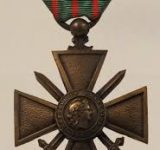Personal Details
Born: 5 September 1884 in Whitchurch, Shropshire and baptised 8 October 1884 at St Alkmund`s Parish Church, Whitchurch.
Family: He was the son of Henry Coulthirst Frith, a plumber and his wife Mary, nee Hayward. He married Jennie Marshall Robson on 7 September 1907 in London City, Middlesex, Ontario, Canada. The couple had six children, Robert, Florence, Jean, Isabella, Joseph and Abiel.
Residence: In 1891 his family were living at 71 Green End, Whitchurch, Shropshire. By 1901 he was a soldier based at the Royal Welsh Fusiliers Barracks, Wrexham, Denbighshire. He emigrated to Canada in 1903. In 1911 and now married, his home was at 375 Glebes Street, London City, Ontario. At the time of his Attestation in 1914 the family had moved to 10 Argyle Street, London, Ontario. By 1927 his home was 34 Oxford Street, London, Ontario.
Employment: When he enlisted in 1914 he was a tailor`s fitter, however at the time of his death he was a dental mechanic.
Died: 7 May 1927 at the Victoria Hospital, London, Ontario, aged 42.
Military Details
Regiment: Royal Canadian Regiment, Canadian Expeditionary Force
Rank: Lieutenant
Service Number: 12937, 53072
Date of Enlistment: 23 November 1914
Date of Discharge: 31 August 1919
Reason for Discharge: Demobilisation
Other Information: He spent 7 years in the Royal Welsh Fusiliers, serving in South Africa during the Second Boer War, before emigrating to Canada.
In 1916 he suffered a severe gunshot wound to his upper jaw and neck which resulted in him having difficulty chewing and swallowing his food.
Joseph was awarded the Military Medal, the Croix de Guerre, the Royal Humane Society Medal and Campaign Medals (1915 Star, British War medal and Victory medal)

The World War I Croix de guerre was established by royal decree on 25 October 1915 as an award for bravery or other military virtue on the battlefield. It was only awarded to individuals. The Croix de guerre was not only awarded for bravery but also for three years or more of service on the front line, or for good conduct on the battlefield. It was also awarded to volunteers older than 40 or younger than 16 after a minimum of 18 months of service, to escaped prisoners of war rejoining the armed forces, and to military personnel who were placed on inactive duty because of injury.
Click on the tag below to see details of each recipient.

The 1914 Star (also known as 'Pip') was authorised under Special Army Order no. 350 in November 1917 and by an Admiralty Fleet Order in 1918, for award to officers and men of the British and Indian Expeditionary Forces who served in France or Belgium between 5 August and midnight of 22–23 November 1914. The former date is the day after Britain's declaration of war against the Central Powers, and the closing date marks the end of the First Battle of Ypres.
The 1914–15 Star (also known as 'Pip') was instituted in December 1918 and was awarded to officers and men of British and Imperial forces who served against the Central European Powers in any theatre of the Great War between 5 August 1914 and 31 December 1915. The period of eligibility was prior to the introduction of the Military Service Act 1916, which instituted conscription in Britain.
The British War Medal (also known as 'Squeak') was a silver or bronze medal awarded to officers and men of the British and Imperial Forces who either entered a theatre of war or entered service overseas between 5th August 1914 and 11th November 1918 inclusive. This was later extended to services in Russia, Siberia and some other areas in 1919 and 1920. Approximately 6.5 million British War Medals were issued. Approximately 6.4 million of these were the silver versions of this medal. Around 110,000 of a bronze version were issued mainly to Chinese, Maltese and Indian Labour Corps. The front (obv or obverse) of the medal depicts the head of George V. The recipient's service number, rank, name and unit was impressed on the rim.
The Allied Victory Medal (also known as 'Wilfred') was issued by each of the allies. It was decided that each of the allies should each issue their own bronze victory medal with a similar design, similar equivalent wording and identical ribbon. The British medal was designed by W. McMillan. The front depicts a winged classical figure representing victory. Approximately 5.7 million victory medals were issued. Interestingly, eligibility for this medal was more restrictive and not everyone who received the British War Medal ('Squeak') also received the Victory Medal ('Wilfred'). However, in general, all recipients of 'Wilfred' also received 'Squeak' and all recipients of The 1914 Star or The 1914/1915 Star (also known as 'Pip') also received both 'Squeak' and 'Wilfred'. The recipient's service number, rank, name and unit was impressed on the rim.

